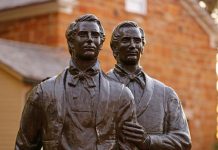
A former BYU professor says that the way we view tithing now is not the same way saints used to view tithing in the early days of The Church of Jesus Christ of Latter-day Saints.
Steven Harper, who now works for the Church History Department, explained that tithing used to be based on net worth, not income. KUTV reports that Joseph Smith received revelation in 1838 as they were trying to raise funds to build a new temple and that LDS scripture explains that tithing should be one-tenth of all annual interest.
While the leaders of the Church now interpret that to mean income, early saints thought of it differently.
Harper writes on LDS.org, “Bishop Partridge understood ‘one tenth of all their interest’ annually to mean 10 percent of what Saints would earn in interest if they invested their net worth for a year.”
Harper also includes a letter from Partridge, written just days after Smith received the revelation, in which Partridge wrote, “If a man is worth a $1000, the interest on that would be $60, and one/10 of the interest will be of course $6. Thus you see the plan.”
Today, however, members follow a different guide. They simply pay ten percent of their annual income. While some members may disagree on whether or not to tithe gross income or net income, and whether or not monetary gifts should also be tithed, Latter-day Saints have the common belief that paying tithing is an expression of gratitude toward God.





